P-9: hopelessly late excellence (part of 2)
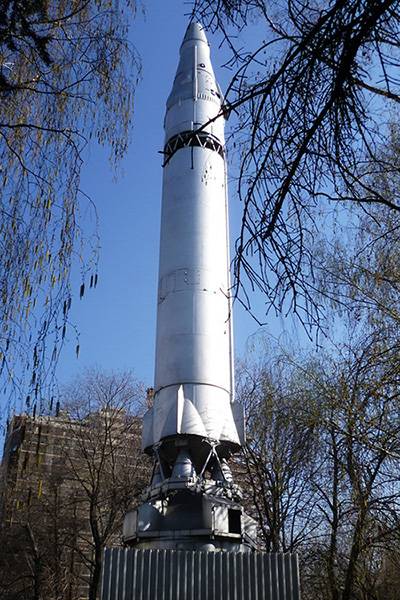
Rocket R-9 on a pedestal at the Central Museum of the Armed Forces in Moscow. Photos from http://kollektsiya.ru
As far as the breakthrough technology turned out to be the use of a central drive in a rocket motion control system, hardware intrigues and relationship problems between the main designers, which nearly led to the failure of the P-9 project, looked so backward on this background. The reason for this was, first of all, fundamental differences and noticeable personal contradictions between Sergey Korolev and Valentin Glushko, who was responsible for the engines of the first stage of the "nine". And they began to manifest themselves long before the P-9 project reached the draft stage.
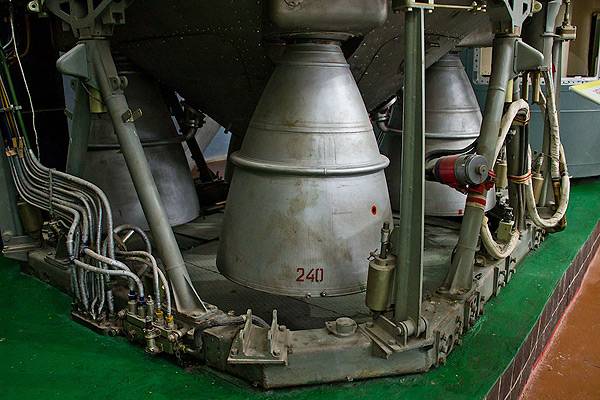
The nozzles of the engine of the first stage of the rocket R-9А, developed in the OKB-456 academician Valentin Glushko Photos from http://cosmopark.ru
"He can not and does not know"
The reason for this was still the same liquid oxygen: Valentin Glushko, who managed to build oxygen engines for the P-7 rocket, categorically objected to repeating this work for P-9. According to one version, the reason for this attitude lay in the pressure that Sergey Korolev had on the leadership of the USSR and the Ministry of Defense, seeking to incorporate the Glushkovsky KB into the co-operation of the nine companies, while Glushko himself sought to cooperate with the Mikhail Yangel Design Bureau and work on the engine for components. According to another version, the cause of all was the failure that pursued Glushko during the work on the engine for the P-9. Academician Boris Chertok recalls:
“In August of the 1960 of the year, fire tests of the P-16 rocket began in Zagorsk. Glushko’s engines on asymmetric dimethylhydrazine and nitrogen tetraxide worked stably. At the same time, new oxygen engines on the stands at the OKB-456 for the P-9 began to shake and destroy the “high frequency”.
The problems that accompanied the initial period of the development of oxygen engines for the P-9, the supporters of Glushko explained the fundamental impossibility at this stage of creating a powerful oxygen engine with a stable mode. Even if he did not want to openly join the disputes, Isaev, in a private conversation with me, said something like the following: “The point is not that Glushko does not want. He simply cannot and does not know yet how to make the process on oxygen in chambers of such large sizes stable. And I do not know. And, in my opinion, no one yet understands the true causes of the emergence of a high frequency. ”
Korolev and Glushko could not agree on the choice of the fuel components. When information was received that Americans used liquid oxygen in Titan-1, Korolev said on the main Council and in negotiations on the Kremlin that this confirms the correctness of our line when creating P-9. He believed that we were not mistaken in choosing P-9A on oxygen, and not P-9B on high-boiling components, on which Glushko insisted.
However, at the end of 1961, information appeared that the same firm, Martin, had created the Titan-2 rocket, designed to destroy the most important strategic targets. Autonomous control system "Titan-2" provided shooting accuracy 1,5 km at a distance 16 000 km! Depending on the distance, the head part was completed with a charge of power from 10 to 15 megatons.
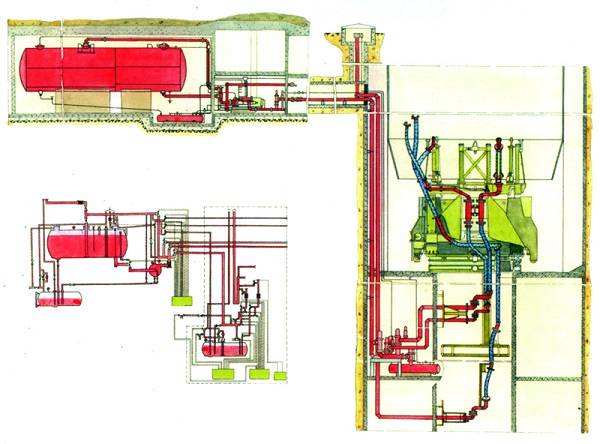
P-9 rocket refueling scheme with liquid fuel components in the Desna B-type silo launcher. Photos from the site http://nevskii-bastion.ru
Missiles "Titan-2" were placed in a single mine launchers in the fueled state and could start a minute after receiving the command. Americans refused oxygen and used high-boiling components. At the same time, data were received on the removal of the Titan-1 from service because it was impossible to reduce the availability time due to the use of liquid oxygen. Now Glushko gloated.
The relationship between the Queen and Glushko were never friendly. The conflict over the choice of engines for the P-9, which began in the 1958 year, subsequently led to an aggravation of personal and official relations, from which both of them and the common cause suffered. ”
As a result, Valentina Glushko’s KB still brought up a series of engines for the first stage of the P-9 in liquid oxygen, although this process took more time and demanded more power than expected. And blame it alone engine will be completely unfair. Suffice it to say that by the time it was time to test the 8D716 engine, also known as P-111, it turned out that for some reason it was not stated in the technical specifications for its development that he would work on supercooled oxygen - and the engine was prepared for operation with ordinary liquid oxygen, the temperature of which was at least ten degrees higher. As a result, another scandal erupted on this basis, which did not improve the already heated atmosphere in which the rocket was created.
It is noteworthy that time eventually confirmed the correctness of Sergei Korolev - but after his death. After Valentin Glushko, in 1974, he headed TsKBEM, which was transformed by OKB-1, on the super-heavy rocket “Energia” created in the walls of this bureau, only liquid-oxygen engines were used. However, it was still a space rocket, not an intercontinental rocket ...
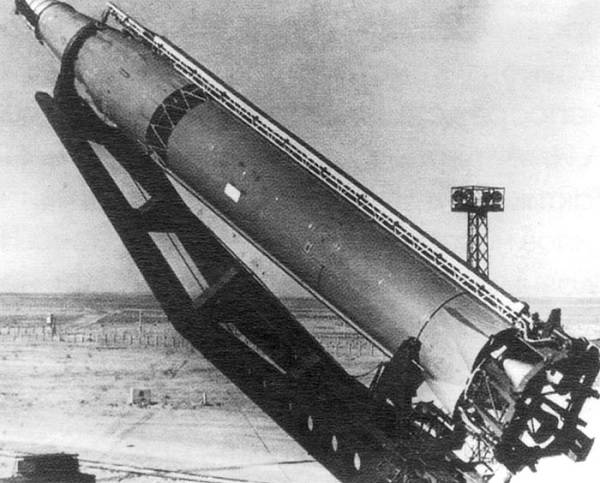
Installing the P-9 rocket on the ground launch pad at the Tyr-Tam test site. Photos from the site http://www.energia.ru
Magic takes for the first run
The most interesting thing is that despite all these hardware contradictions and technical difficulties, the P-9 rocket was ready for the first flight tests at the appointed time. The first start of the “nine” was assigned to 9 on April 1961 from the Baikonur test site, and the goal was the Kamchatka Kura test site, which had been aimed at not only the first year for all newly created and already in service missiles during test and control launches. From the memoirs of Boris Chertok:
“In March, the X-NUMX of the year for fitting the P-1961 was first installed on the launching table and we were able to admire it. The strict and perfect forms of the still mysterious “Nine” differed sharply from the “Seven”, which knew all the polygon life, entwined with multi-storey steel farm maintenance, refueling and cable masts. The P-9 did gain a lot in comparison with its older sister in terms of starting mass. With a range equal to or even longer than that of the P-9, a charge with a power of 7 megatons fit into its head. Let me remind you that the "seven" carried 1,65 megatons. But does it make such a big difference - turn the city into ashes from being hit by 3,5 or 80 Hiroshima bombs?
The beauty and severity of the “nine” forms were given not for nothing. The fight against extra pounds of dry weight was carried out irreconcilably. We fought for kilometers of distance with a rigid weight policy and improvement of the parameters of all systems. Glushko, despite the fear of self-excitation of high-frequency vibrations, increased the pressure in the chambers compared to the G-7 and designed the RD-111 engine for the N-9 very compact. ”
Alas, the first launch was unsuccessful: the rocket left the launch pad as expected, but then at the 153 second flight there was a sharp drop in the operating mode of the engine of the “B” block, and after another minute and a half the engine was turned off. As it turned out on the same day, the reason for the failure was a single valve responsible for the flow of gas into the general turbopump unit, distributing it between the four combustion chambers. This malfunction triggered the pressure switch, which determines the end of the fuel components, and the engine, figuratively speaking, was deprived of power.
But this could not be the only fault that could have caused a bad start. Another managed to eliminate one of the main specialists in P-9, who was present at the start, and a very nontrivial way. Says Boris Chertok:
“Preparation for the first launch of the rocket took place with a big delay. In ground automatic control of refueling found errors that interfered with the set of readiness. With a five-hour delay, they finally reached a fifteen-minute readiness. Resurrection (Leonid Resurrection, test-rocket, one of the closest associates of Sergei Korolev. - Approx. Aut.), Who was at the periscope, suddenly announced:
- Give all services a fifteen minute delay. Turning to us, he said that there was a noticeable flow of oxygen from the flange connection at the starting table.
-I'll check out. Ostashev (Arkady Ostashev, Leading Tester of Missiles and Space-Rocket Complexes OKB-1. - Note. Aut.) With me, the rest of the bunker does not go!

Р-9 on the launch pad of the ground platform at the Tyura-Tam (Baikonur) training ground. Photos from the site http://www.energia.ru
I and Mishin watched through the periscope. Two, without haste, walked to the starting table shrouded in white pairs. Resurrection, as always, in its traditional beret.
“Lyonya, even here with her walk, flaunts,” Mishin could not resist.
Resurrection in emergency situations was in no hurry, he walked upright, not looking at his feet, with a peculiar, peculiar gait. He did not hurry because in a duel with another unexpected defect he concentrated and considered the forthcoming decision.
Having examined the floating connection, Voskresensky and Ostashev, slowly, disappeared behind the nearest wall of the launch facility. Two minutes later, the Resurrection again appeared in sight, but without a beret. Now he walked resolutely and quickly. On an outstretched hand, he carried something and, going up to the table, put this “something” on the floating flange. Ostashev also approached, and, judging by the gestures, both were pleased with the decision. After standing at the table, they turned and went to the bunker. When the walking figures moved away from the rocket, it became clear that the flow had ceased: there were no more swirling white fumes. Returning to the bunker without a beret, Voskresensky took his place at the periscope and, without explaining anything, re-announced a fifteen-minute readiness.
In the 12 hours of 15 minutes, the rocket was wrapped in flames scattering starter debris, and roaring, abruptly went towards the sun. The first stage fulfilled its 100 seconds. Telemetry on the speakerphone reported: "The separation has passed, the transitional compartment has been reset."
At 155, the second was followed by a report: “Failures, failures! .. In failures, loss of stabilization is visible!”
For the first start and it was not bad. The first stage, its engine, control system, central drive, the start of the second stage engine, hot separation, the discharge of the second stage tail section are checked. Then came the usual report that the film urgently taken to the MIC for development.
“I will go and look for a beret,” Voskresensky once said vaguely, heading for the “zero” mark.
Someone from the soldiers who joined the search found it at about twenty meters from the launch pad, but Voskresensky did not put it on, but carried it in his hand, not even trying to put it in his pocket. He answered my dumb question:
- It would be necessary to wash.
From Ostashev, we learned the details of an impromptu repair of the oxygen line. Hiding behind the nearest wall from oxygen vapor, Voskresensky took off his beret, threw it on the ground and ... urinated. Ostashev joined and also added moisture. Then Voskresensky quickly carried the wet beret to the leaking flange and, with the virtuosity of an experienced surgeon, precisely applied it to the leak. For a few seconds, a solid ice crust patched the rocket’s oxygen feed.
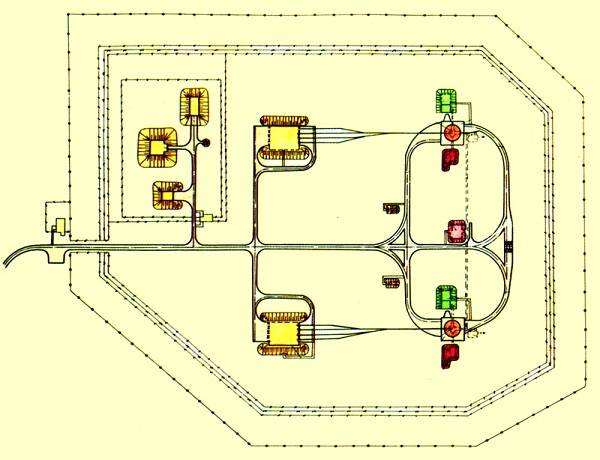
The scheme of the land launch pad type "Valley". Photos from the site http://nevskii-bastion.ru
From the ground and out of the ground
Of the X-NUMX launch of the P-41, which were part of the first stage of the flight test of the rocket, the emergency 9 turned out to be — that is, slightly less than half. For the new technology, and even as complex as an intercontinental ballistic missile, this was a very good indicator. By the way, the second test launch, which was held on 19 on April 24, shortly after the world-famous launch of Yuri Gagarin, was successful. The rocket started strictly according to the schedule, all the engines worked as it should, the steps split in time, and the head part flew safely to Kamchatka, where it fell at the Kura range. At the same time, the shortfall to the target was only 1961 meters, and the deviation was slightly more than 300.
But to refine and force the “nine” itself to fly - this was not enough. It was also necessary to provide it with starting positions. But with this there were some difficulties. The first version of the ground launch, called "Desna-N", according to the test results, did not recognize the tactical and technical requirements of the customer as appropriate and did not recommend for use. In particular, the transitional frame turned out to be too heavy and inconvenient in operation, which was created as a means of accelerating the prelaunch preparation and was part of the rocket itself. It was to this frame that all the ground-to-side transient connections docked on the technical position, and on the launch pad it was necessary to connect only adapters from the frame to the desk equipment. Alas, even with the use of such innovation, the technological cycle of rocket preparation was two hours - and it was about minutes already!
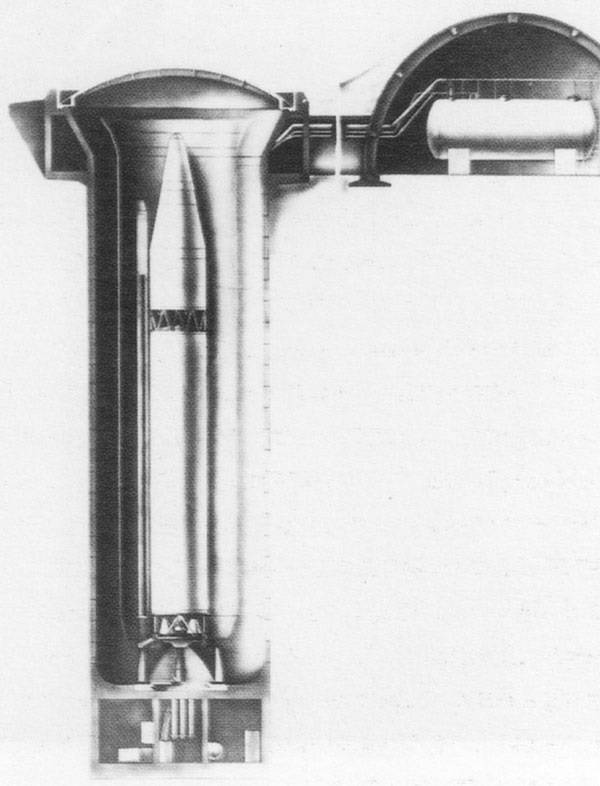
General view of the mine launcher for missiles P-9 type "Desna-B". Photos from the site http://www.energia.ru
The starting position for the P-9, which had the code name Desna-V, was much more successful. The first launch of a rocket from such a mine took place on 27 on September 1963 of the year, and turned out to be quite successful. Both the launch and the entire missile flight were in full compliance with the program, and the warhead hit the target on Kura with the flight of 630 meters and the deflection of 190 meters. By the way, it was in the mine version of the launch that another innovative idea was implemented by Vasily Mishin, who proposed to create a rocket on supercooled oxygen - a continuous recharge of the R-9 on alert on this component. As a result, the loss of liquid oxygen was reduced to 2-3% per year - an incredible figure for this type of missile! And most importantly, due to this, it was possible to submit for adoption a system that ensured the rocket stay in the state of readiness number one (that is, not filled with all the components of the fuel) for one year, provided that it is on it - without removing it from the start! - regular maintenance work was carried out periodically. If the start command was received, then according to the standards, 20 took minutes to complete the technological preparation, and most of the time was spent on the promotion of the gyroscopes of the guidance system.
However, it was also possible to solve the problem with a ground launch, creating a quite successful “Dolina” launcher. Here they used a completely unheard of for those years, but which later became a classic solution for maximally automating the process of preparing and installing a rocket on the launch pad, which now took just half a minute. The corresponding automated system was developed in OKB-1 itself and manufactured at the Krasnaya Dawn plant. The launch process at the Dolyna site looked like this: a self-propelled rocket cart withdrew from the assembly and test case and went to the trigger. Reaching the stops, she connected with the lifting-mounting device, and then raised it to a vertical position, automatically docked all communications and fixed the rocket on the launch pad. After that - and also automatically, without participation of the calculation! - a high-speed filling of rocket fuel components, preparation of the control system and aiming were carried out. The system that connected the second stage with the ground was also noteworthy: for this purpose, a single-use cable mast was installed on the rocket straight from the factory, called the onboard communications chute.
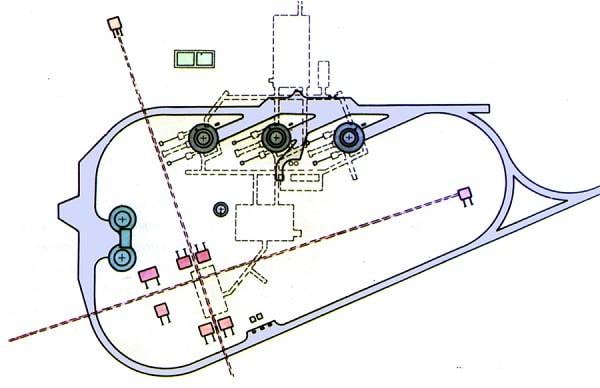
The layout of the objects included in the underground launch pad for the P-9 missiles of the Desna-B type. Photos from the site http://nevskii-bastion.ru
The victim of big politics
21 July 1965, the intercontinental ballistic missile R-9A (i.e., a modification with liquid oxygen engines as an oxidizer) was put into service. But the rocket’s long life was not destined: oxygen intercontinental rockets had already gone off the scene, and the P-9 was the last of them. Last - and probably that is why one of the best.
This is how the person who knows the Seven and Nines thoroughly describes her - the leading designer of P-7 and P-9, and then the general director and general designer of the Samara State Scientific and Production Rocket and Space Center "TsSKB-Progress" Dmitry Kozlov:
“Our intercontinental N-9 was smaller and lighter in weight (80 tons versus 86) than the single-stage medium-range missile Mikhail Yangel P-14, although it exceeded it almost fourfold in the enemy's defeat range! .. It had a powerful, but powerful a compact thermonuclear “head” in 5-10 megatons and a sufficiently high for those times defeat accuracy: a circular probable deviation of no more than 1,6 km. We were able to bring the technical readiness for launch in the mine version up to 5 minutes, which was three times better than the American Titan.
At the same time, the “nine” possessed a whole set of unique qualities that made it one of the best in its class. Due to the selected components of rocket fuel, it was non-toxic, its engines were high-energy, and the fuel itself was quite cheap. “A special advantage of the P-9A over other rocket systems was the relatively short stretch of the first-stage engine,” noted Dmitry Kozlov. - With the advent of the United States of the intersection system of intercontinental ballistic missile launches through the powerful torch of the engines, this became the undoubted advantage of the Nine. After all, the shorter the torch lifetime, the more difficult it is for missile defense systems to react to such a rocket. ”

Rocket R-9A in the museum on the basis of the Training Center of the Military Academy of the Strategic Missile Forces. Peter the Great (Balabanovo, Kaluga region). Photos from http://warfiles.ru
But even at the peak of the deployment of a group of missiles, the P-9A as part of the Strategic Missile Forces was not armed with more 29 launchers. Regiments armed with “Nines” were deployed in Kozelsk (Desna-V mine launchers and Dolina ground launchers), Tyumen (Dolina land launchers), Omsk (Desna-V mine launchers) and the first of the launch areas of the combat missiles was the Angara facility, the future of the Plesetsk cosmodrome, which used the Dolina ground launchers. Launched both types of launchers and test site "Tyura-Tam", aka Baikonur.
The first regiment - in Kozelsk - took over the 14 December 1964 combat duty of the year, a day later it was joined by the regiment in Plesetsk, and the last R-9A missiles were deactivated in the 1976 year. The main competitor, the Yangelevka P-16, outlasted them by just a year, serving up to the 1977. It is difficult to say what were the reasons for the fact that these well-proven missiles were removed from combat duty. But the formal reason was iron: this was done under the SALT-1 agreement, signed by Leonid Brezhnev and Richard Nixon ...
Information